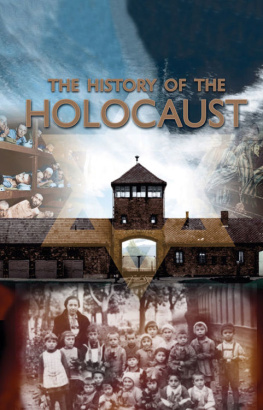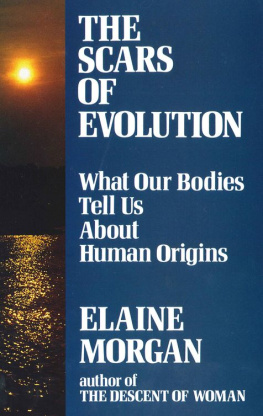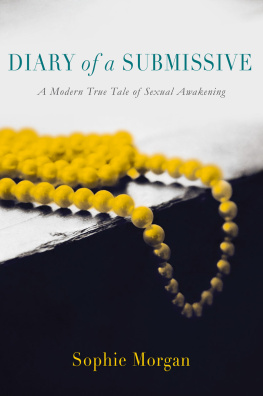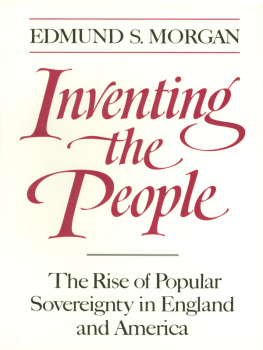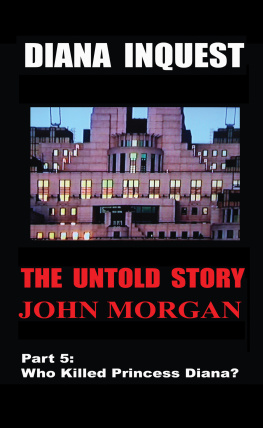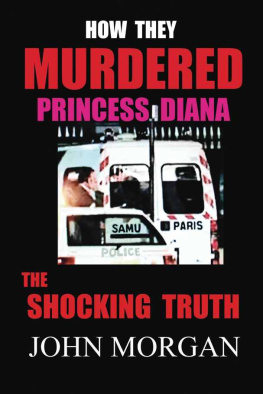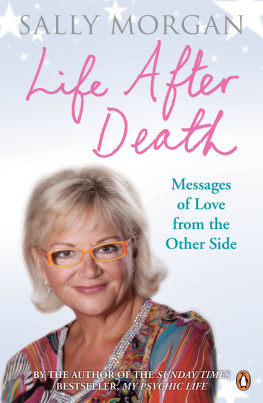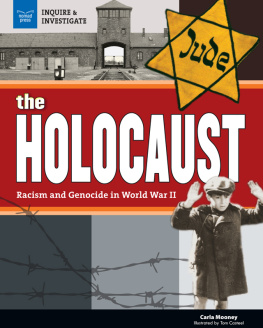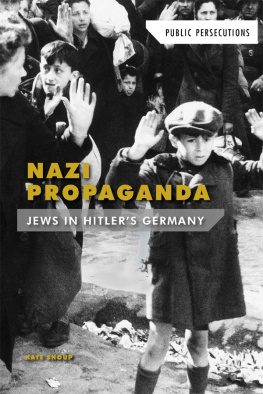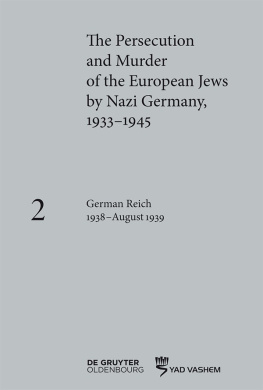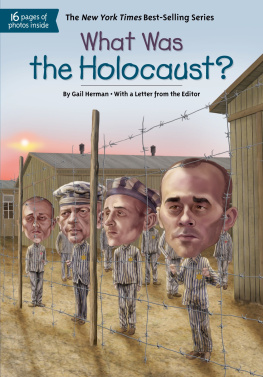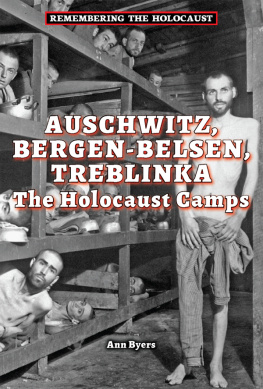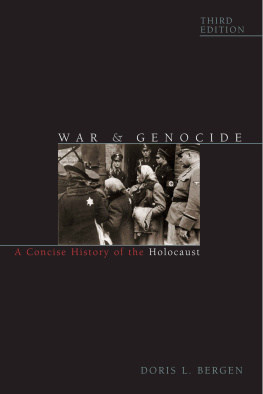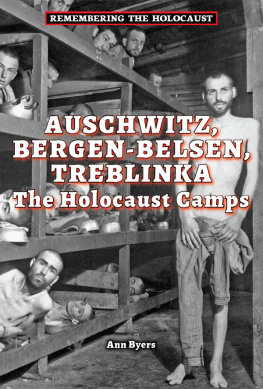The History
of the Holocaust
Pat Morgan
G2 Rights Ltd 2015. All rights reserved.
Publishers: Edward Adams and Jules Gammond for G2 Rights Ltd
This version published in the UK in 2015 by G2 Rights Ltd,
Unit 7, Whiffens Farm, Clement Street, Hextable, Kent, BR8 7PQ
The right of Pat Morgan to be identified as the author of this book
has been asserted by them in accordance with the Copyright,
Designs and Patents Act 1988.
This book is sold subject to the condition that it shall not, by way of trade or otherwise, be lent, resold, hired out, or otherwise circulated without the publishers prior consent in any form of binding or cover other than that in which it is published and without a similar condition, including this condition being imposed on the subsequent purchaser.
All rights reserved. No part of this publication may be reproduced, stored in a retrieval system, or transmitted in any form or by any means, electronic, mechanical, photocopying, recording or otherwise, without the prior permission in writing of all the copyright holders.
ISBN: 978-1-78281-964-6
The views in this book are those of the author but they are general views only and readers are urged to consult the relevant and qualified specialists for individual advice in particular situations.
G2 Entertainment hereby exclude all liability to the extent permitted by law of any errors or omissions in this book and for any loss, damage or expense (Whether direct or indirect) suffered by a third party relying on any information contained in this book.
Introduction
F rom 1933 until 1945, the Nazi regime in Germany waged a brutal war on groups of people whom they considered inferior among them Jews, Roma, Slavs and the disabled and on political opponents and religious enemies. Jews, whom the Nazis believed were the creators of their countrys downfall, were particular targets. At first through discrimination and persecution but later through violence, enslavement and mass murder, the Nazis carried out a pitiless attempt to eradicate an entire people.
The word Holocaust stems from classical Greek, in which it meant literally wholly burnt, and the word was later used to signify a sacrifice by fire. Perhaps a better description of the attempted liquidation of the Jews and others lies in the Hebrew word Shoah: calamity or destruction. Whichever term you prefer, they both adequately convey the emotional impact of the tragedy.
Although the Holocaust was ended in 1945, it was not until the early 1960s that the scale and meaning of the years of murder began to be truly appreciated in the western world. After World War II, it seemed to the European peoples that the reconstruction of their shattered countries was more important than chasing after the perpetrators of genocide; and the existence of the Cold War meant that much documentation of the Holocaust lay hidden behind the Iron Curtain.
In the early 1960s, two events occurred that led to many a historian embarking on a mission to uncover the true history of the Holocaust: in 1960 a principal player in the genocide, SS-Obersturmbannfhrer Adolf Eichmann, was abducted by Mossad agents in Argentina and put on trial in Israel; and in 1961 an art historian, Gerald Reitlinger, published his book The Final Solution: the Attempt to Exterminate the Jews of Europe. Eichmanns trial (he was executed in Israel in 1962) and Reitlingers book served to focus historians attention on the Holocaust, and the whole truth started to trickle out.
Over time, the trickle became a flood and today anyone who wishes to study the course of the Holocaust, its causes and its effects has a vast range of resources at his or her disposal. This book contributes in a very small way to those resources.
Readers who want to arrive at a better understanding of the events of the Holocaust must have some knowledge of the history of the persecution of the Jewish people in Europe and elsewhere. That history dates back two thousand years to the time of Jesus Christ and the Roman Empire, and has been marked by countless attempts to punish the Jews for perceived defects and misdeeds. There must be an understanding, too, of Germany in the decades leading up to World War II: of how the perverted, racist ideology of Adolf Hitler and the Nazis came to the fore; of how and why Germany accepted that ideology and those men. Maybe, once the reader has studied a little of the precedents of the Holocaust, he or she will be able to comprehend the enormity of its atrocities.
Aharon Appelfeld is a distinguished Israeli novelist who emigrated to Palestine in 1946 and has lived in Israel ever since. Born in what is now Ukraine in 1932, he was eight years old when his mother was killed by invading Nazi forces and he was deported with his father to a concentration camp.
Appelfeld escaped from the camp and survived the Holocaust. He says: The Holocaust is a central event in many peoples lives, but it also has become a metaphor for our century. There cannot be an end to speaking and writing about it.
Sure enough, there never will be an end to speaking and writing about the Holocaust.
Chapter 1
The background to genocide
I f you want to arrive at some kind of understanding of the cruel minds that conceived and carried out the most appalling and infamous acts of genocide of the twentieth century, you need to delve way back in history.
Adolf Hitler and his henchmen, it is true, were unique products of twisted political thinking, of unnatural hatred and of ideas born in minds that were diseased and cynically manipulated. They were also unique in their savage desire to rid a continent of an entire people. But they were far from unique in their antipathy towards the Jewish race, as the history of many centuries shows very clearly.
The sheer, terrible scale of the mass murders of the Holocaust is unrivalled, as we must hope it always will be. The idea that killing Jews was justified is, however, almost as old as the story of Jesus Christ.
The Jews have long been vilified by some of the more stupid elements of Christendom as the killers of Jesus, the man they did not accept as the Messiah. And a few short years after the death of Christ, in the first and second centuries AD, the ruthless Roman Empire overcame a series of uprisings by the Jewish people in Israel to send them on many lifetimes of wandering throughout Europe and elsewhere. The Jews had become a stateless people and the Jewish Diaspora the scattering of a people had begun.
The Jews were made truly welcome in very few places, for all too often Christian people regarded them as the enemies of Christ. Indeed, all too often the Christian people of Europe took it upon themselves to persecute, demonise and murder their Jewish visitors. Preceding Hitler by seven hundred years, massacres took place in English cities in the 13th century. Even before then, German Crusaders on their way to reclaim the Holy Land had stopped off on the way to murder Jews, blaming them for the death of Christ.
The centuries that followed were marked by relentless discrimination and persecution. Jews gained unenviable reputations as cruel moneylenders Catholics were forbidden by their Church to lend money with interest and Shakespeares Shylock character in The Merchant of Venice would have been a familiar caricature to Elizabethan audiences. In a rabidly anti-Semitic society, Jews were portrayed as evil, grasping and wily.
Even when the Reformation began to offer Christians alternatives to the Catholic Church in the sixteenth century, its leading light, Martin Luther, made it clear that he saw the Jews as blasphemers and liars, and indicated that they should be converted to Christianity. Know, Christian, wrote Luther, that next to the devil you have no enemy more cruel, more venomous and violent than a true Jew.

